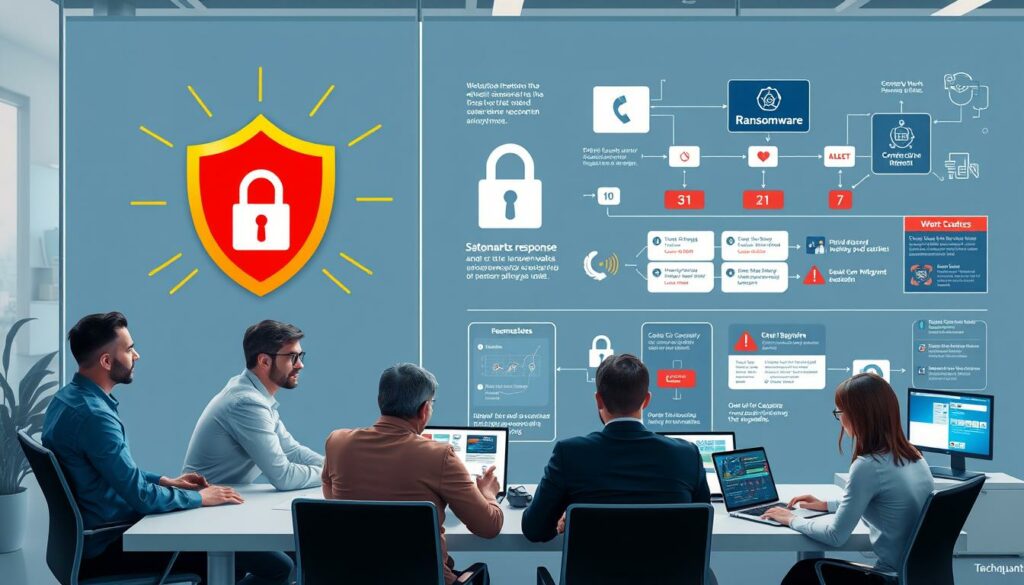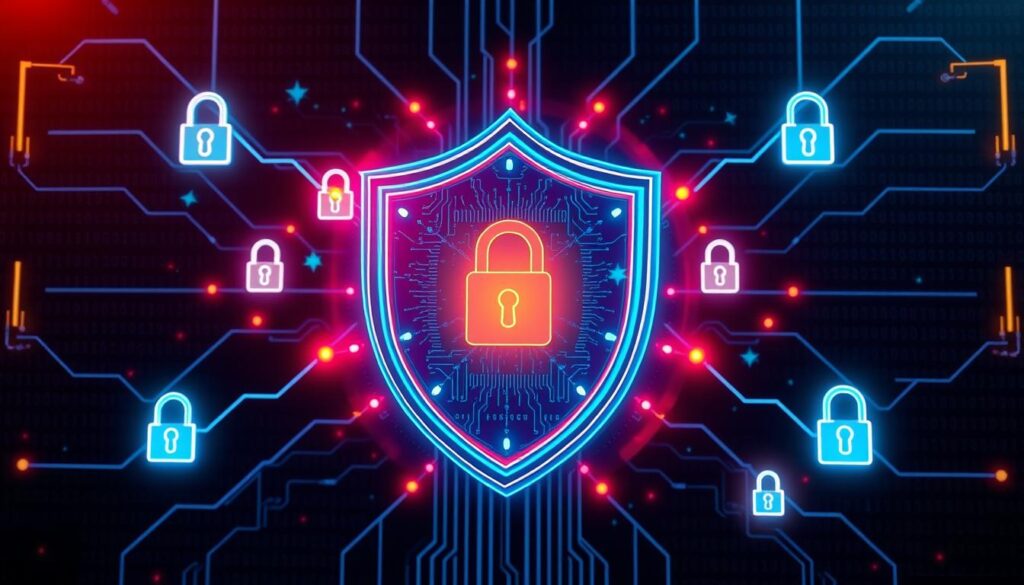In 2023, businesses worldwide faced losses over $110 million from ransomware attacks. This shows a big increase in this threat. It’s clear that as ransomware gets better, it’s a big risk to your business. You need strong cybersecurity to protect your data.
Ransomware attacks are on the rise and you need to pay attention. It’s important to know how ransomware works and its impact on your business. This malware encrypts your data and demands a ransom to unlock it. With criminals always changing their ways, staying informed and proactive is key.
Putting IT security first can help protect your business from ransomware. This article will show you how to stay safe from these cyber threats. It will cover strategies and steps to keep your business secure.
Key Takeaways
- Ransomware attacks have resulted in over $110 million in losses in 2023.
- Staying informed about ransomware is essential for effective business protection.
- Cybersecurity measures are vital to safeguard sensitive data from ransomware threats.
- The increasing sophistication of attacks means evolving strategies for protection.
- Implementing strong IT security can significantly reduce risks associated with ransomware.
Understanding Ransomware: The Growing Threat
Ransomware is a big threat to businesses all over the world. It encrypts files and demands payment to get them back. Knowing what ransomware is helps protect against this danger.
What is Ransomware?
This malware makes data unavailable unless a ransom is paid. Victims can suffer from big losses and damage to their reputation. It’s not just a tech problem but a big threat to security and stability.
Recent Statistics on Ransomware Attacks
Looking at recent trends shows how big of a problem ransomware is. In 2024, attacks went up by 18% from the year before. This shows how cybercriminals are getting better at what they do. Ransomware statistics show the average ransom payment has gone up, with one payment reaching $75 million. This shows we need strong cybersecurity.
| Year | Ransomware Attacks Increase (%) | Average Ransom Payment ($) |
|---|---|---|
| 2022 | 12% | 300,000 |
| 2023 | 18% | 1,000,000 |
| 2024 | 18% | 75,000,000 |
Understanding ransomware and its stats is key to protecting your business from this big threat.
The Financial Impact of Ransomware on Businesses
Ransomware attacks are a big worry for companies. They can lead to huge financial losses. These attacks often require big ransom payments, causing disruptions and draining resources. High-profile cases show the huge costs of these attacks.
Ransom Payments and Business Losses
Ransom demands can be in the millions. Companies must decide quickly whether to pay to get their data back. The downtime and recovery efforts add to the financial stress. Companies face big challenges from ransomware in their operations, reputation, and profits.
Case Studies: Colonial Pipeline and Halliburton
The Colonial Pipeline incident in 2021 is a key example. They paid $4.4 million in ransom to get back up and running. This shows the big financial hit from ransomware and the need for strong protection.
On the other hand, Halliburton faced unauthorized data access but said it wouldn’t hurt their finances much. This shows the tough fight energy firms have against cyber threats and keeping their finances stable.
Cybersecurity: A Key Element in Ransomware Protection
In today’s world, cybersecurity is more important than ever. More businesses use digital transactions and cloud services. This makes protecting against ransomware crucial. Cybercriminals keep getting better at what they do, and without strong cybersecurity, companies can get hit hard.
The Importance of Cybersecurity in Today’s Environment
Ransomware attacks are hitting all kinds of organizations. Recently, in Columbus, Ohio, the Rhysida group took 6.5 terabytes of sensitive data. This shows we need strong cybersecurity to protect our data and personal info, especially for vulnerable groups like crime victims and kids.
With threats getting worse, it’s key to focus on cybersecurity. This helps lower risks and keeps important info safe.
Cybersecurity Trends and Innovations
New trends in cybersecurity are moving towards proactive defense. Zero Trust models are becoming popular because traditional defenses aren’t enough. With more companies using the cloud, keeping software updated and security strong is key to stopping ransomware.
Keeping up with these changes helps you prepare for threats. It also helps you fight cybercrime better.
As cyber threats change, we need to keep learning and investing in new cybersecurity tools. The legal talks after the Columbus attack show how complex data breaches can be. They also show the importance of having good responses to these issues.
Staying on top of cybersecurity trends helps your business deal with these issues well.
For more on the legal and ethical sides of data breaches and their impact, check out this detailed article.
Common Ransomware Attack Vectors
It’s key to know how ransomware gets into systems to protect your data. Ransomware can enter through many ways, putting your data at risk. This part talks about two main ways: phishing emails and social engineering, and malware using software flaws.
Phishing Emails and Social Engineering
Phishing is a top way hackers get into systems, targeting people in companies. They send fake emails to make people click on bad links or download dangerous files. Social engineering tricks people by making them think something urgent or important is happening.
Teaching your team to spot phishing can cut down on these attacks. For tips on boosting your cybersecurity, check out this resource.
Malware and Vulnerabilities in Software
Malware that targets software flaws is another big threat. Many companies don’t update their software fast enough, making them easy targets. Once in, attackers can spread ransomware through these flaws. Keeping software updated is key to avoiding these risks.
| Attack Vector | Description | Preventative Measures |
|---|---|---|
| Phishing Emails | Fraudulent emails designed to trick users into revealing sensitive information or downloading malware. | Implement employee training on identifying suspicious emails. |
| Social Engineering | Manipulative tactics used to persuade individuals to bypass security protocols. | Maintain awareness programs focusing on common social engineering techniques. |
| Software Vulnerabilities | Exploits targeting outdated or unpatched software allowing unauthorized access. | Conduct regular software updates and vulnerability assessments. |
| Malware | Malicious software designed to damage or disrupt systems, often delivered through email attachments or compromised websites. | Install and update antivirus software consistently. |
How to Increase Your Business’s Cybersecurity Posture
Improving your cybersecurity means using many layers of protection. Two key steps are important: using strong passwords and keeping software updated. These steps help protect against cyber threats.
Implementing Strong Password Policies
Strong passwords are the first defense against hackers. Make sure your passwords have letters, numbers, and symbols. Change these passwords often to stop cybercriminals and teach your team about security.
Regular Software Updates and Patching
Old software can be a weak spot for hackers. It’s crucial to update and patch your software regularly. This keeps your data safe from breaches. Think about using an automated system for software updates. This way, all apps are always checked and kept safe. This helps lower security risks and builds a strong defense against cyber threats.
| Security Measure | Description | Benefits |
|---|---|---|
| Strong Password Policies | Require complex passwords and regular changes. | Reduces unauthorized access risks. |
| Regular Software Updates | Keep software up-to-date and apply patches promptly. | Shields against known vulnerabilities. |
| User Education | Train employees on password hygiene and security best practices. | Fosters a mindful security culture. |
| Two-Factor Authentication | Enhance login security with an additional verification step. | Provides an extra layer of protection. |
Creating a Response Plan for Ransomware Incidents
Having a strong ransomware response plan is key to lessening the harm from cyber attacks. A good plan lays out what to do first and who does it. It also covers how to talk to each other. Your team needs to know what to do fast if hit by ransomware.

What to Include in an Incident Response Plan
Your plan should have key parts:
- Identification: Spot and figure out the ransomware type and its effect on your systems.
- Containment: Use tactics to stop the ransomware from spreading more in your network.
- Eradication: Get rid of the ransomware from systems without losing more data.
- Recovery: Bring back systems and data from backups, fixing any weak spots that let the attack happen.
- Communication: Tell everyone about the incident and how you’re fixing it.
Doing well in a response needs clear plans and getting ready. Keep important contacts and resources ready for a cyber attack to help talk and work together.
Roles and Responsibilities during a Cyber Incident
It’s important to set clear roles for cyber incidents to improve how your team responds. Everyone should know what they’re supposed to do, making things run smoother in a crisis. Some main roles are:
| Role | Responsibilities |
|---|---|
| Incident Response Manager | Lead the response and keep everyone informed. |
| IT Security Lead | Look into the attack and lead the tech response. |
| Legal Advisor | Give advice on following the law and what the incident means legally. |
| Public Relations Officer | Handle talking to the public and the media about the incident. |
| Human Resources | Help with talking to employees and any people needs. |
Knowing these roles helps things run better when attacked. Doing drills and exercises helps everyone get used to the plan. It also makes your team work better together. Spending time training your team means you’ll be ready and strong when hit by ransomware.
For more tips on boosting your cybersecurity, check out this link.
Employee Training: Your First Line of Defense
In today’s fast-changing cybersecurity world, training your employees is key. They are often the first ones to stop cyber threats, like ransomware. Teaching your team to spot phishing attempts helps lower the risk of these threats.
Recognizing Phishing Attempts and Scams
Phishing is a big problem for cybercriminals. It’s important to teach your employees how to spot suspicious emails and scams. Here are some tips:
- Teach them to be wary of emails they didn’t ask for, especially those that ask for personal info.
- Make them check email addresses closely, as attackers often use fake ones.
- Alert them to emails that try to make them act fast.
For more tips on improving cybersecurity with employee training, see this resource.
Best Practices for Secure Remote Work
Remote work has made keeping work safe more important. Here are some tips for your team:
- Use Virtual Private Networks (VPNs) to make internet connections safer.
- Teach employees how to keep their home networks safe.
- Have strong password rules and suggest using password managers.
Adding these tips to your training makes your cybersecurity better and your work environment safer.
Utilizing Advanced Technologies in Cybersecurity
In today’s digital world, advanced cybersecurity technologies are key to fighting off new threats. Zero Trust security models have changed how we keep data and systems safe. They make sure only verified people can access resources, cutting down on unauthorized breaches.
Adding AI threat detection helps us spot and act on threats fast. This means we can quickly deal with anything that looks suspicious.
Zero Trust Security Models
The Zero Trust idea says we shouldn’t trust anyone right away, inside or outside the company. We must always check who and what we let in. This method greatly lowers the chance of cyber attacks.
For example, Indiana put $20 million into cybersecurity to help 31 local agencies. This kind of investment makes governments more secure against cyber threats.
The Role of A.I. in Threat Detection
Using AI threat detection helps fight cyber threats before they happen. AI looks at lots of data to find patterns and oddities, spotting threats better than old methods. This is vital as cyber attacks grow, like the 300 percent jump in ransomware attacks on water systems from 2021 to 2023.
Advanced cybersecurity technologies are key to reducing risks. It’s important for smaller groups to use funding programs, like Minnesota’s $23.5 million cybersecurity effort.

Legal and Compliance Considerations
It’s crucial for businesses to understand the legal side of ransomware. They must follow specific laws, especially those related to GDPR compliance. This means they need to notify about data breaches quickly and know how to protect data.
Understanding GDPR and Relevant Regulations
GDPR is key to protecting personal data in the European Union. Companies dealing with EU citizens’ data must follow its rules. Being GDPR compliant is not just about avoiding fines; it also builds trust and credibility. Important points include:
- Ensuring data minimization and purpose limitation.
- Implementing strong security measures for data protection.
- Providing transparent information to users about data processing.
Reporting Obligations Following a Cyber Attack
After a cyber attack, reporting it quickly is crucial. Under GDPR, companies must tell the authorities about data breaches within 72 hours. Not doing so can lead to big fines and harm your reputation. Here’s what to do:
- Assess the breach and figure out how big it is.
- Tell the people affected right away.
- Keep a record of what you did to handle the attack.
| Compliance Aspect | Description | Legal Obligation |
|---|---|---|
| Data Breach Notification | Promptly inform authorities and affected parties | Within 72 hours under GDPR |
| Documentation | Maintain records of breaches and responses | Mandatory under GDPR |
| Data Security Measures | Implement measures to prevent future breaches | Required by GDPR |
Conclusion
Ransomware threats are on the rise, making it crucial to act early in cybersecurity. We’ve seen how important it is to understand these attacks to protect your business. With hackers always getting better, it’s key for companies to stay alert and ready to change.
Using strong strategies like training your team and advanced tech can really help fight ransomware. Keeping your cybersecurity strong helps protect your business and its important assets. Learning more, like through programs like the EM MSIPP STARS program, prepares you for new cyber threats.
Staying up-to-date with the latest in cybersecurity helps you keep your business safe. This means making plans, training your team, and using new tech. Putting these things first helps you defend against ransomware and other cyber dangers.
FAQ
What is ransomware and how does it work?
Ransomware is a type of malware that encrypts files on a device. This makes the files inaccessible. Attackers then ask for a ransom in exchange for a decryption key. This can cause big financial losses and disrupt operations.
Why has ransomware become a growing threat for businesses?
Ransomware attacks are becoming more common, with a jump of 18% from last year. This is due to cybercriminals’ growing sophistication and the digital reliance of many organizations. Protecting IT security is now crucial.
How can businesses protect themselves from ransomware attacks?
Businesses can boost their defense with strong cybersecurity steps. This includes strict password rules, keeping software updated, and training staff to spot phishing scams. These actions lower the risk of an attack.
What should an incident response plan include?
A good incident response plan should detail steps to take during a ransomware attack. It should cover roles, communication, and recovery steps after the attack.
What role does employee training play in defending against ransomware?
Training employees is key as they often spot threats first. Teaching them to recognize phishing and follow secure practices helps boost IT security, especially in remote work settings.
How does using advanced technologies enhance cybersecurity?
Advanced technologies like Zero Trust Security and AI for threat detection help ensure only authorized users access data. They also allow for quick monitoring and response to threats. This strengthens business protection.
What are the legal obligations related to ransomware attacks?
Companies must follow laws like GDPR, which demand quick reporting of data breaches. Knowing these laws helps reduce legal risks and improve data protection efforts.
Source Links
- https://www.bleepingcomputer.com/news/security/ftc-americans-lost-over-110-million-to-bitcoin-atm-scams-in-2023/
- https://www.stocktitan.net/news/ZS/zscaler-reports-fourth-quarter-and-fiscal-2024-financial-wix4mqmpan64.html
- https://www.darkreading.com/threat-intelligence/evolving-npm-package-campaign-roblox-devs
- https://www.theregister.com/2024/09/03/spamouflage_trolls_us_elections/
- https://industrialcyber.co/cisa/cisa-unveils-zero-trust-guidance-to-safeguard-connected-communities/
- https://www.zdnet.com/article/one-of-the-best-e-ink-tablets-ive-used-is-not-by-remarkable-or-amazon-kindle/
- https://securityboulevard.com/2024/09/columbus-sues-expert-fueling-debate-about-ransomware-attack/
- https://therecord.media/government-is-not-ready-for-food-agriculture-cybersecurity-usda
- https://www.govtech.com/security/what-do-cities-and-counties-get-from-whole-of-state-cyber
- https://www.insurancebusinessmag.com/nz/news/cyber/new-zealand-cybersecurity-leaders-push-for-gender-inclusivity-and-equity-504069.aspx
- https://www.forbes.com/sites/keithferrazzi/2024/09/03/when-cyber-security-breaches-are-inevitable-its-time-to-call-for-a-new-approach/
- https://www.malwarebytes.com/blog/news/2024/09/city-of-columbus-tries-to-silence-security-researcher
- https://www.csoonline.com/article/3497163/how-to-ensure-cybersecurity-strategies-align-with-the-companys-risk-tolerance.html
- https://www.felhaber.com/uncategorized/the-nlrbs-expanding-scrutiny-of-non-solicitation-agreements/
- https://www.marketscreener.com/quote/stock/ADC-THERAPEUTICS-SA-66481721/news/ADC-Therapeutics-Makes-Grants-to-New-Employees-Under-Inducement-Plan-47794483/
- https://www.govtech.com/security/critical-infrastructure-how-to-protect-water-power-and-space-from-cyber-attacks
- https://www.govtech.com/education/indiana-student-creates-worlds-smallest-robot-arm
- https://www.bankinfosecurity.com/halliburton-says-hackers-stole-data-a-26185
- https://www.govinfosecurity.com/radiology-vendor-hack-hits-4-practices-411000-people-a-26186
- https://www.bankinfosecurity.com/3-men-plead-guilty-to-running-service-that-bypasses-mfa-a-26184
- https://www.energy.gov/em/articles/em-msipp-stars-scholars-shine-conclusion-internship
- https://natlawreview.com/article/seventh-circuit-clarifies-parties-rights-jury-trial-when-pursuing-equitable-aiding
- https://www.baselinemag.com/business-intelligence/optimizing-email-deliverability-advanced-techniques/
- My Insights on IT projects post-war in Europe
- Augmented Reality in Marketing: Top Strategies for Success
- What Nobody Tells You About AI: My Insights
- Inside Netflix’s Tech Stack: A Captivating Behind-the-Scenes Look
- Generation Tech Zombie: Thriving in the Digital Age
Related posts:
 How to Protect Your Business from Ransomware Attacks
How to Protect Your Business from Ransomware Attacks
 Cybersecurity in the Cloud: Best Practices for Keeping Data Safe
Cybersecurity in the Cloud: Best Practices for Keeping Data Safe
 Firewalls and VPNs: How They Work Together to Secure Networks
Firewalls and VPNs: How They Work Together to Secure Networks
 Phishing Attacks: How to Spot and Prevent Them
Phishing Attacks: How to Spot and Prevent Them
 IAM Introduction: Identity Access Management Basics
IAM Introduction: Identity Access Management Basics
 CISSP Domain 3: Security Architecture and Engineering
CISSP Domain 3: Security Architecture and Engineering
